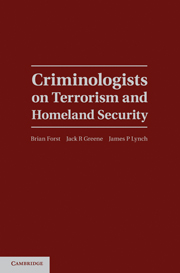Book contents
- Frontmatter
- Contents
- About the Authors
- Preface
- 1 Introduction and Overview
- PART I NATURE OF THE PROBLEM
- PART II STRATEGIES FOR INTERVENTION
- 7 Is Crime Prevention Relevant to Counterterrorism?
- 8 Implications of Opportunity Theory for Combating Terrorism
- 9 Soldiers and Spies, Police and Detectives
- 10 Community Policing and Terrorism
- 11 Go Analyze!
- 12 Managing the Fear of Terrorism
- 13 Should Profiling Be Used to Prevent Terrorism?
- 14 Federal-Local Coordination in Homeland Security
- 15 Liberty and Security in an Era of Terrorism
- 16 Regulating Terrorism
- PART III THINKING ABOUT TOMORROW
- Index
- References
12 - Managing the Fear of Terrorism
Published online by Cambridge University Press: 04 February 2011
- Frontmatter
- Contents
- About the Authors
- Preface
- 1 Introduction and Overview
- PART I NATURE OF THE PROBLEM
- PART II STRATEGIES FOR INTERVENTION
- 7 Is Crime Prevention Relevant to Counterterrorism?
- 8 Implications of Opportunity Theory for Combating Terrorism
- 9 Soldiers and Spies, Police and Detectives
- 10 Community Policing and Terrorism
- 11 Go Analyze!
- 12 Managing the Fear of Terrorism
- 13 Should Profiling Be Used to Prevent Terrorism?
- 14 Federal-Local Coordination in Homeland Security
- 15 Liberty and Security in an Era of Terrorism
- 16 Regulating Terrorism
- PART III THINKING ABOUT TOMORROW
- Index
- References
Summary
It's absolutely essential that eight weeks from today, on November 2nd, we make the right choice, because if we make the wrong choice then the danger is that we'll get hit again.
– Vice President Dick Cheney (2004)I approved this message: “I want to look into my daughter's eyes and know that she is safe, and that is why I am voting for John Kerry.”
– Senator John Kerry (2004)THE PROBLEM OF FEAR IN THE ERA OF TERRORISM
Prior to September 11, 2001, people in the United States were especially fearful of rapists and robbers, airplane crashes and cancer, hurricanes and sharks. On that day, and for years afterward, terrorism became Public Fear Number One. Although the 1993 bombing of the World Trade Center and the 1995 Oklahoma City bombing of the Murrah Federal Building were sensational events, they did not shake ordinary citizens to their core, as did the 2001 attack. Two great oceans had insulated the United States from serious acts of violence by foreign sources, and its citizens were protected by the strongest military on earth. The jet hijacking and suicide bombings that killed nearly 3,000 people, brought down the twin towers of the World Trade Center in New York, and inflicted major damage on the Pentagon in Washington raised fear in the United States to a new level entirely.
- Type
- Chapter
- Information
- Criminologists on Terrorism and Homeland Security , pp. 273 - 299Publisher: Cambridge University PressPrint publication year: 2011
References
- 1
- Cited by



